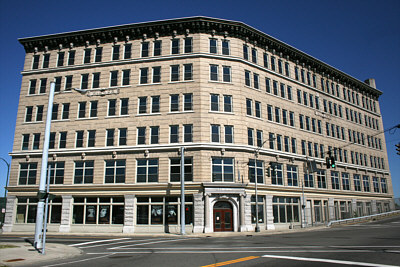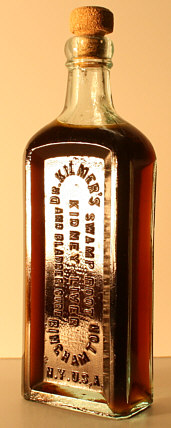 "When you step off the railroad train, the Swamp-Root laboratory is the first striking object that confronts you - a beautiful, white, high-towering building."
This description of a first impression on arriving in Binghamton and seeing the Kilmer Building, appeared in a 1917 issue of New York Sunday World. The article continued: "In many respects this building stands unique. The main office is wholly unlike anything of the kind in the country. The massive columns of solid marble and beautiful hand-carved molding, cornices and ceiling, and the marble mosaic floor, is of a type that forces admiration."
"When you step off the railroad train, the Swamp-Root laboratory is the first striking object that confronts you - a beautiful, white, high-towering building."
This description of a first impression on arriving in Binghamton and seeing the Kilmer Building, appeared in a 1917 issue of New York Sunday World. The article continued: "In many respects this building stands unique. The main office is wholly unlike anything of the kind in the country. The massive columns of solid marble and beautiful hand-carved molding, cornices and ceiling, and the marble mosaic floor, is of a type that forces admiration."
For the past three years a major project has been quietly taking place in downtown Binghamton. The Kilmer Building, on the corner of Chenango and Lewis Streets is being renovated to its former grandeur.
 Originally built in 1903 as the manufacturing facility for "Dr. Kilmer's Swamp-Root", it later housed the Lander Company, finally closing in 1987. Swamp-Root, a patented mixture of natural herbs, oils and grain alcohol, was marketed as a kidney, liver and bladder cure. It was concocted by Sylvester Andral Kilmer, a medical doctor who moved to Binghamton in 1879. Andral and his brother Jonas formed a medicine business to produce and sell the product.
Originally built in 1903 as the manufacturing facility for "Dr. Kilmer's Swamp-Root", it later housed the Lander Company, finally closing in 1987. Swamp-Root, a patented mixture of natural herbs, oils and grain alcohol, was marketed as a kidney, liver and bladder cure. It was concocted by Sylvester Andral Kilmer, a medical doctor who moved to Binghamton in 1879. Andral and his brother Jonas formed a medicine business to produce and sell the product.
In 1892 Jonas' son Willis Sharpe Kilmer, a recent graduate of Cornell University, took over the firm's advertising department, and through the use of creative advertising techniques quickly transformed the small company into a multi-million dollar enterprise. Within just a few years the company was shipping several rail-car loads of Swamp-Root out of Binghamton each day, to destinations as far away as Europe, South America, and Australia.
The original Swamp-Root factory was a complex of buildings located on the corner of Chenango and Virgil Streets. It was destroyed by fire in 1900, and three years later the present six-floor, eight-story fireproof building was completed - Binghamton's first skyscraper.
Besides producing Swamp-Root, the new building was the birthplace of what would eventually become the Press and Sun Bulletin. By all reports, Willis Sharpe Kilmer was not particularly pleased with local press coverage of his affairs. So, in 1903 he started publishing his own newspaper in the Kilmer Building, and the following year constructed the Press Building on Chenango Street to house the operation.
Following Willis' death the Kilmer Building changed ownership a few times, ultimately being acquired by the Lander Company and used for manufacturing and bottling perfumes. The Lander company vacated the building twenty years ago, and to this day a faint scent of perfume can be detected on some of the upper floors.
In 1996 the Broome County Industrial Development Agency received the building as a contribution from the Lander Company, and after being vacant for nine years, good things were about to happen… or so it would seem. Plans were announced to relocate Broome County Economic Development offices into the building and use the rest of the space as a business incubator. In 1997, headlines stated that the Kilmer Building would be getting a $2.4 million overhaul to transform it into office space, which was "expected to begin this week and to be completed end of 1998". The business incubator concept made headlines again in 2001: "KILMER BUILDING TO COME ALIVE. Renovation could create hundreds of jobs by 2003." In spite of the headlines, the news conferences, and the political rhetoric, nothing happened. The building sat empty, deteriorating with each passing year.
Meanwhile, lifelong area residents Frank and Lynn Whitney continued to admire the magnificent Kilmer Building. Located just down the street from their business, each day they drove past and often dreamed of owning the building. In 2004 they took the plunge and bought it. Finally, after sitting vacant for seventeen years, the Kilmer Building would truly come alive again.
Artisans and craftsmen were brought in to renovate the building. Brian Davis of Davis Design, meticulously restored and replaced the decorative plaster work on the column capitals and ceiling. "As Brian worked up on the scaffold we started calling him Michelangelo", Frank Whitney said. Slowly, one at a time the building's magnificent architectural details came to life.
Managing the renovation since the beginning has been Dan Maciak. "It was a mess when we started", Dan said, "but the building is in great shape". He went on to say that structurally it is in excellent condition, it is "one of the last riveted steel buildings made, and will probably be here for another 500 years."
Now, three years after starting the effort and just weeks before the grand opening by its first business tenant, the Whitneys smile when asked if they'd do it all over again. They concede it was definitely a bigger job than they had imagined, Frank jokingly adds, "we've spent our retirement savings on this and will be working the rest of our lives to pay the mortgage". But it's clear they have no regrets.
The first business to open is The Goldsmith. Relocating from its current home in the MetroCenter mall, owner Gina Mowry McHugh said she considered several locations for her fine designer jewelry business. Once she saw the Kilmer Building she was sold. "It's perfect", she said, adding that the architecture of the building is an ideal complement to her business. McHugh, who designed every aspect of her new facility, plans to be open for business in a few weeks, with a grand opening scheduled for First Friday October 5th.
An interesting feature can be found in McHugh's shop. In one of the side rooms there is a small opening in one of the walls. Maciak explains: "when we stripped paint off one of the columns we discovered a pencil sketch drawn on the plaster." Turns out, the sketch was the original design drawing for the ornate brass collars installed at the top of each column. The new layout called for a wall next to the column, so an opening was designed into the wall to display the original drawing.
Whitney explained that the other half of the first floor is occupied by a restaurant offering French cuisine and American seasonal food. The "Kilmer Brasserie and Steakhouse" is the creation of owner Jean Baptiste Mavian (known as "JB"). "Of course the menu would not be complete without the restaurant's trademark drink… Swamp-Root Cocktail", said Whitney, explaining that the drink is made to the patented Kilmer formula. The restaurant is scheduled to open a few weeks after The Goldsmith, he added, "hopefully by the end of October."
Whitney plans to lease the upper floors for office space. His business, CMS Imaging Solutions, will share the top floor with a currently undisclosed tenant. He went on to say, "We plan to lease four of the floors by the end of the year and have the building fully occupied by the end of 2008."
Over the course of three years, Frank and Lynn Whitney have done what had been talked about since 1987. They saved one of this area's most historic and magnificent treasures, and with it breathed new life into downtown Binghamton. But they have done something even more significant: Frank Whitney explained, "we put the building in a trust, so it will never go into disrepair again. When we're gone we are giving it back to the community for future generations."
So on October 5th during First Friday festivities, stop in to the Kilmer Building. Pick up a Swamp-Root Cocktail, but before taking that first sip, look around at the magnificent architecture, imagine the original grand opening a hundred years ago, and raise a toast to Frank and Lynn Whitney!

